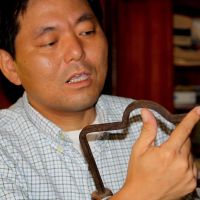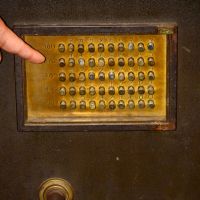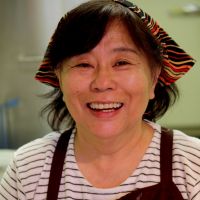Sometimes it's hard to see the forest for the trees. According to Akinori Saito, a historian in Tokyo's Koto Ward Office, the area known as Morishita (lit. "forest below") was most likely named for woods that surrounded the yashiki (residence) of a feudal lord named Saemon Sakai (1564-1619), a retainer of the first Tokugawa shogun, Ieyasu. However, as I emerge from Morishita Station, on both the Shinjuku and Oedo subway lines, it's into one of the least forested places I've ever seen.
With Morishita having been razed in firestorms that followed the Great Kanto Earthquake of 1923, and then blitzed repeatedly by U.S. bombs during World War II, its woods now most certainly remain in name alone.
Hoping to unlock more of the area's history, I head to the Safe and Key Museum, five minutes from the station. Yasushi Sugiyama, a third-generation key, lock and safe expert, opens his private museum by appointment only, and only on the first and third weekends of the month. I am expected, so he ushers me into a room crammed with safes, combination locks, keys and key-cutting machinery. The room's still air suspends the faintest tinge of machine oil.
In the habit of entertaining children, Sugiyama, 45, whips out a model of a 4,000-year-old Egyptian lock. It's a sliding-bolt mechanism secured by gravity pins, and it opens with a wooden key that angles in and nudges the pins just high enough to allow the bolt to slide free. I note that the key looks like a giant toothbrush. "That's what all the kids say," he tells me.
After Sugiyama demonstrates an early African lock, and several simple but ingenious Japanese sliding-door keys from the Edo Period (1603-1867), I lock eyes on the museum's most unusual item: a 1937 safe in which military documents classified "top secret" were kept during World War II. "It's the real thing, and one of a kind," Sugiyama tells me, pointing out the paulownia-wood cabinetry inside and the panel of Japanese katakana characters and rotary dial, both of which have to be manipulated in precise combinations to open the safe.
Then Sugiyama reveals a hidden panel inside the door. "There was a counter locked inside, so each time the safe door was opened, a new number clicked over. Someone tracked how many times the secret documents were accessed, so they would know if the contents had been compromised." This last detail gives me the creeps, so I ask about a slightly broken trophy in a corner of the museum.
"My grandfather won it appearing as an expert on a TV show years ago," Sugiyama says. "It toppled in the recent March 11 quake." So, has Sugiyama offered to help open some of the many safes now among the mountains of debris following that day's Tohoku tsunami? "Of course not," he says, eyes bulging and lips pursed. "If the bona fide owner of a safe asked me to, I would, but safes are sensitive territory. You don't want a stranger opening them, and sometimes what's inside is beyond your imagination."
I can tell Sugiyama has some "unsafe" safe stories, so before he gets too keyed up, I thank him and move on.
As I wend through the sleepy residential backstreets of Morishita, I glimpse elderly men in pajamas chatting in the alleys and housewives watering plants in front of postwar homes. Only as I approach the main intersection of Shin Ohashi and Kiyosumi avenues again do I happen across ice distributor Kishi Himuro, with kakigōri (shaved ice) flags flapping outside the shop.
I pop in to chat with Satomi Kishi, 55, her husband Yoshio, 62, and their 25-year-old son, Yohei. As Yohei expertly picks ice blocks into saleable-size chunks, Satomi sets the kakigōri machine whirring and tells me her business has supplied ice to establishments around the city for 90 years. She tamps my kakigōri into a perfect ball and I choose from the 17 flavored syrups (including mango and "blue Hawaii") a prosaic lemon. I pay ¥100 and take a straw with a spooned end — a spraw? — and dig in. The syrup is very sweet, but the ice is ethereal, like eating frozen feathers.
My tongue now numb, I wave goodbye to the Kishi family, whereupon I clock a window next door that's filled with antique watches. I enter the hushed display room at Carese (pronounced "cares"), purveyor and repairer of quality timepieces.
President Tomokazu Kawase recounts how, as a junior high student, he tried to repair a broken gold watch his father had given him. "I took it apart, thinking I could fix it, but then I completely ruined it." However, he realized that with proper skills, good watches could be fixed — and so began a lifelong passion.
When quartz watches were first introduced to the market by Seiko on Christmas Day, 1969, they were more accurate and cheaper to manufacture than conventional ones. But, as Kawase remarked, "they were meant to be replaced, not repaired. That is indicative of our current throwaway mentality, which is not good. We really should take good care of things."
In the 1980s, Kawase haunted flea markets, cruised closure sales and built up his own watch collection along with his knowledge. Today he has 20 employees and two shops: Carese in Omotesando specializes in women's watches; the Morishita shop in men's watches and repairs.
Carese offers free repair and overhaul estimates on the second floor, but the third floor is where things really get ticking. Following Kawase, I find a scene out of the 1800s. Repair meisters hang their elbows on eye-level desktops, examining through loupes the complex innards of Rolexes, Piagets and Hamiltons, replacing teeny flame-blued watch hands, or calibrating movements. "And here," says Kawase, "are drawers of donor parts salvaged from old watches that were beyond repair."
I could spend hours in this engrossing universe of jewels and gears, but time has flown and so, with a nod to Kawase for his kindness, I wind up my visit.
Outside again, I pass a small shop making obanyaki — crispy pancake shells filled with bean paste or custard. Enmusubi no Obanyaki offers seven different fillings, each one branded with the face of one of Japan's seven lucky gods. From her tiny shop, Yu Kojima does a swift business among locals and students returning home from school.
I cross the street and, seeing that soba shop Kyokin Teuchi offers handmade noodles, I drop in for lunch. The Watanabe family, it turns out, have been serving up soba since 1830, though they moved to their present location as recently as 1894. "My great, great, great grandfather was Shogun Ienari Tokugawa's cook," Mitsuyoshi Watanabe tells me.
Feeling suddenly grand, I order the cold oroshi soba (¥1,470), which arrives with a generous hummock of grated daikon and pink dried bonito shavings. Mixed with the buckwheat noodles, the radish has a cool bite to it, and the meal tastes refreshingly healthy.
As I pay the check, Mitsuyoshi's wife, Naomi, informs me that the restaurant is hosting a rakugo (traditional storytelling) event that afternoon. Would I care to attend? Absolutely, I say, and reserve a seat.
In the meantime, I wander east along Shin Ohashi-dori, realizing as I do that I could eat my way through the animal kingdom in Morishita. At Kinchan Chi, a pub known for its yakitori (skewered chicken) and ¥10 appetizers, I find frogs and lizards on the menu. "Mostly guys order the lizards," remarks employee and Morishita native Shinichi Noda, 22. "They cost ¥980, but they're big." Nice.
Nearby, a new branch of the popular Gindaco chain serves takeout takoyaki (octopus dumplings), and a bit further on, restaurant Yamariki has been ladling out its signature stew of beef intestines since 1924. Fourth-generation master Kenichi Yamada, 33, warns me (in fluent English) that long lines form on weekends, and reservations are recommended even on weekdays.
A bit further on, below a gilt wooden shop sign, is Minoya, Tokyo's renowned premier restaurant specializing in sakura-niku (horsemeat).
Fifth-generation chef Mamaru Nagasei, 42, emerges from his kitchen to chat. "Long ago, eating four-legged animals was sort of taboo in Japan," he explains. "But people in the countryside needed protein. So, since horsemeat is the color of certain types of cherry blossoms, the term 'sakura' was probably used as a euphemism."
Minoya's meat, sourced from Aomori and Canada, differs little from beef, Nagasei claims, except it takes longer to age, is lower in calories, has less odor and is higher in protein. Minoya's interior has a traditional, and old feeling, opening as it does onto a pretty garden.
"Actually, Morishita burned to the ground several times," Nagasei says, "and our place too. During the war, my Morishita grandparents decided to trade homes for a while with other family members in the countryside. The day they switched homes, Morishita was bombed." Nagasei's mother sits nearby as he tells me this, nodding.
I head back to the soba restaurant, where Mitsuyoshi confides that, unlike Nagasei's lucky grandparents who moved out at just the right time, his were killed in the wartime bombings.
On the second floor of Kyokin, I sit among locals — some quite old, others young and elegant in yukata (summer kimonos) — preparing to watch rakugo raconteur Senko Irifunetei. His choice of story, "Aona," is the Edo Period tale of a wealthy lord and his gardener, and gradually, the forests of times past emerge.





